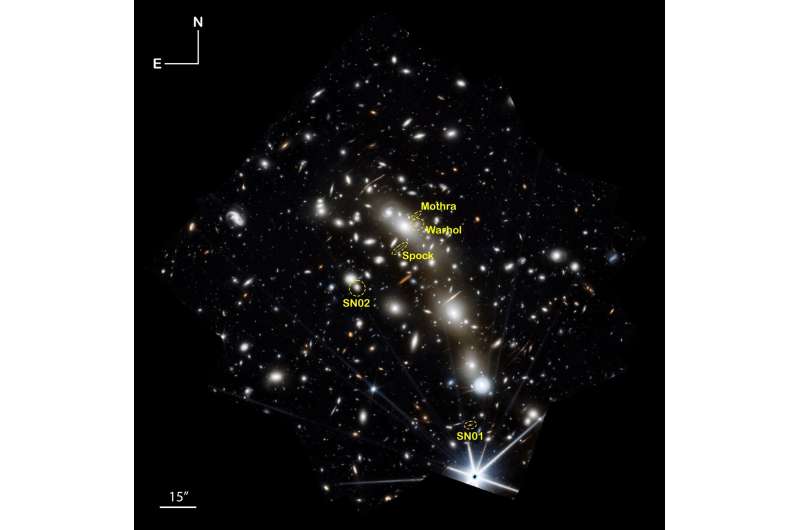This article has been reviewed according to Science X's editorial process and policies. Editors have highlighted the following attributes while ensuring the content's credibility:
fact-checked
peer-reviewed publication
trusted source
proofread
Scientists find 14 new transient objects in space by peering through the 'Christmas Tree Galaxy Cluster'

An international team of scientists, led by University of Missouri's Haojing Yan, used NASA's James Webb Space Telescope (JWST) to discover 14 new transient objects during their time-lapse study of galaxy cluster MACS0416—located about 4.3 billion light years from Earth—which they've dubbed "The Christmas Tree Galaxy Cluster."
"Transients are objects in space, like individual stars, that appear to suddenly brighten by orders of magnitudes and then fade away," said Yan, an associate professor in the Department of Physics and Astronomy.
"These transient objects appear bright for only a short period of time and then are gone; it's like we're peering through a shifting magnifying glass. Right now, we have this rare chance that nature has given us to get a detailed view of individual stars that are located very far away. While we are currently only able to see the brightest ones, if we do this long enough—and frequently enough—we will be able to determine how many bright stars there are, and how massive they are."
Using the advanced technological capabilities of the JWST, Yan and his team, including Mizzou graduate student Bangzheng Sun, confirmed what's causing the galaxy cluster's "flickering lights" or transients that scientists first saw years ago using NASA's Hubble Space Telescope.
"We're calling MACS0416 the Christmas Tree Galaxy Cluster, both because it's so colorful and because of the flickering lights we find within it," Yan said. "We can see so many transients in certain regions of this area because of a phenomenon known as gravitational lensing, which is magnifying galaxies behind this cluster."
The team discovered the transients by studying four sets of images taken by JWST of the galaxy cluster over a period of 126 days, or about four months. Yan is particularly excited that two of the transients are supernovae—stars that are at the end of their lifespans—because the team can use them to study the supernovae's host galaxies.
"The two supernovae and the other twelve extremely magnified stars are of different nature, but they are all important," Yan said. "We have traced the change in brightness over time through their light curves, and by examining in detail how the light changes over time, we'll eventually be able to know what kind of stars they are. More importantly, we'll be able to understand the detailed structure of the magnifying glass and how it relates to dark matter distribution. This is a completely new view of the universe that's been opened by JWST."
"JWST's PEARLS: Transients in the MACS J0416.1-2403 Field" has recently been accepted for publication in the Astrophysical Journal. It's currently available on the arXiv pre-print server.
More information: Haojing Yan et al, JWST's PEARLS: Transients in the MACS J0416.1-2403 Field, arXiv (2023). DOI: 10.48550/arxiv.2307.07579
Journal information: arXiv , Astrophysical Journal
Provided by University of Missouri





















